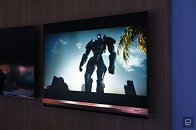Raevenlord
News Editor
- Joined
- Aug 12, 2016
- Messages
- 3,755 (1.17/day)
- Location
- Portugal
| System Name | The Ryzening |
|---|---|
| Processor | AMD Ryzen 9 5900X |
| Motherboard | MSI X570 MAG TOMAHAWK |
| Cooling | Lian Li Galahad 360mm AIO |
| Memory | 32 GB G.Skill Trident Z F4-3733 (4x 8 GB) |
| Video Card(s) | Gigabyte RTX 3070 Ti |
| Storage | Boot: Transcend MTE220S 2TB, Kintson A2000 1TB, Seagate Firewolf Pro 14 TB |
| Display(s) | Acer Nitro VG270UP (1440p 144 Hz IPS) |
| Case | Lian Li O11DX Dynamic White |
| Audio Device(s) | iFi Audio Zen DAC |
| Power Supply | Seasonic Focus+ 750 W |
| Mouse | Cooler Master Masterkeys Lite L |
| Keyboard | Cooler Master Masterkeys Lite L |
| Software | Windows 10 x64 |
China-based Hisense came out at CES 2019 with quite an ingenious new display solution that has (speculatively) a much better chance of faster PC monitor integration that OLED. OLED's implementation in PC monitors has been excruciatingly slow despite recent developments of the technology - mainly due to some underlying problems for PC's mostly fixed-image use-cases with its UI elements. As a result, display technology in the monitor space has been somewhat stagnant. Hisense, with its dual-panel ULED XD solution, whoever, could have a much cheaper and easier to implement solution that could bring another technology player to the PC monitor market.
The ULED XD solution basically crams two panels in front of the LED array. One is a 4K, RGB VA panel. This is your run-of-the mill implementation. However, there's a second panel sandwiched between the RGB and LED array in the form of a greyscale, 1080p resolution panel. What does this particular implementation offer, you ask? Well, it just so happens that different lighting conditions across the same RGB image are expanded upon by the grayscale monitor, even if it works at a lower resolution - it only serves to increase contrast if high and low luminosity areas, with black areas being supported by the blacks of the grayscale monitor. And even at that resolution, look at these as local dimming zones - over 2 million of such across a single panel.


Of course, a fancy new technology in no way means fast adoption from the market. Manufacturing costs, panel yields, and many other factors come into play - especially considering the PC monitor's required features. But that's where this tech actually could have an advantage over, say, microLED - it's just much cheaper to produce, easier to implement, and doesn't have the same yield constraints as that technology. A 4K RGB display is today a run-of-the mill production, and a 1080p grayscale panel is expectedly even more so. Whether this solution is even capable of employing VRR technology is something else entirely - two panels will have to be perfectly synced for that to happen, but then again, they'll have to be perfectly synced to display any image as well.
It's an interesting new take on old technologies, which Hisense says allows the TV (the product on display at CES 2019) to achieve more than 2,900 nits of brightness and the "highest dynamic range" seen on an LCD panel. Inspiring stuff.
View at TechPowerUp Main Site
The ULED XD solution basically crams two panels in front of the LED array. One is a 4K, RGB VA panel. This is your run-of-the mill implementation. However, there's a second panel sandwiched between the RGB and LED array in the form of a greyscale, 1080p resolution panel. What does this particular implementation offer, you ask? Well, it just so happens that different lighting conditions across the same RGB image are expanded upon by the grayscale monitor, even if it works at a lower resolution - it only serves to increase contrast if high and low luminosity areas, with black areas being supported by the blacks of the grayscale monitor. And even at that resolution, look at these as local dimming zones - over 2 million of such across a single panel.


Of course, a fancy new technology in no way means fast adoption from the market. Manufacturing costs, panel yields, and many other factors come into play - especially considering the PC monitor's required features. But that's where this tech actually could have an advantage over, say, microLED - it's just much cheaper to produce, easier to implement, and doesn't have the same yield constraints as that technology. A 4K RGB display is today a run-of-the mill production, and a 1080p grayscale panel is expectedly even more so. Whether this solution is even capable of employing VRR technology is something else entirely - two panels will have to be perfectly synced for that to happen, but then again, they'll have to be perfectly synced to display any image as well.
It's an interesting new take on old technologies, which Hisense says allows the TV (the product on display at CES 2019) to achieve more than 2,900 nits of brightness and the "highest dynamic range" seen on an LCD panel. Inspiring stuff.
View at TechPowerUp Main Site






